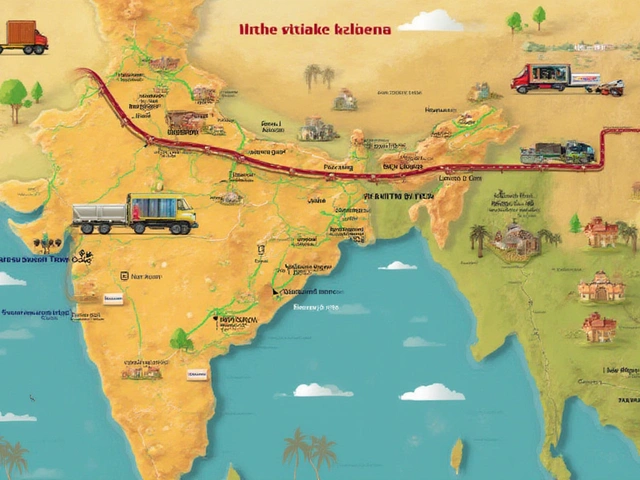Courier Price Calculator
Courier cost calculation is a formulaic process that carriers use to turn a shipment’s characteristics into a final price. It blends base fees, weight measurements, distance, service level, and optional add‑ons into one number you see on the checkout screen. Understanding each piece lets shippers predict costs, compare carriers, and trim unnecessary spend.
TL;DR - Quick Takeaways
- Base rate covers handling and the minimum distance.
- Weight is measured as actual or dimensional weight, whichever is higher.
- Distance translates into zones; farther zones add a surcharge.
- Service level (standard, express, same‑day) multiplies the subtotal.
- Fuel surcharge, insurance, and customs fees are optional add‑ons.
Key Factors that Drive the Price
Every courier puts a price tag on a parcel based on a handful of tangible inputs. Below are the major entities you’ll encounter on any rate‑calculator.
- Package weight: Measured in kilograms or pounds. Heavier parcels push the cost up linearly once they cross weight thresholds.
- Dimensional weight: Calculated as (Length×Width×Height)/dimensional factor. Carriers compare this to actual weight and charge the greater of the two.
- Shipping distance: Expressed as zones (Zone1, Zone2, …) or mileage brackets. Longer trips increase the per‑kilometer charge.
- Service level: Standard, Express, Same‑Day. Each tier carries a multiplier - e.g., Express may be 1.5× the standard base.
- Fuel surcharge: A variable percent (often 5‑15%) added to offset fuel price volatility.
- Zone classification: Geographic grouping that simplifies distance pricing and aligns with carrier networks.
- Base rate: Fixed fee covering pickup, handling, and minimal mileage. Serves as the price floor.
- Insurance coverage: Optional cost based on declared value, typically 0.5‑2% of the insured amount.
Step‑by‑Step: From Parcel to Price
- Gather the package dimensions and actual weight.
- Compute dimensional weight using the carrier’s factor (e.g., 5000 for kg, 139 for inches). Compare to actual weight and pick the higher value.
- Identify the origin and destination zones. Most carriers publish a zone map linking zip codes or postal codes to zones.
- Lookup the base rate for the chosen service level.
- Apply the weight‑based rate tier (e.g., $2.00 per kg up to 5kg, $1.75 per kg thereafter).
- Add the zone surcharge (e.g., $0.30 per km or a flat $5 for Zone3).
- Multiply the subtotal by the service‑level multiplier (Standard=1.0, Express=1.4, Same‑Day=2.0).
- Calculate the fuel surcharge as a percentage of the running total.
- If you add insurance, compute insurance cost and append.
- Round according to carrier policy (most round to the nearest cent).
The final figure you see on the checkout page is the sum of all those line items.
Real‑World Example
Imagine a Toronto‑based e‑commerce shop shipping a 12×8×6in box weighing 3lb to a customer in Vancouver.
- Actual weight = 3lb.
- Dimensional weight = (12×8×6)/139≈4.1lb → use 4.1lb.
- Chosen service: Express (multiplier 1.4).
- Zone: Toronto to Vancouver falls in Zone4.
- Base rate for Express = $4.00.
- Weight charge = 4.1lb×$1.80=$7.38.
- Zone surcharge = $6.00 (flat for Zone4).
- Subtotal = $4.00+$7.38+$6.00 = $17.38.
- Apply Express multiplier: $17.38×1.4=$24.33.
- Fuel surcharge (10%): $2.43.
- Total before insurance = $26.76.
- Optional insurance for $50 value at 1% = $0.50.
- Final cost = $27.26.
This walk‑through shows how every factor adds up and why a tiny change in dimensions can swing the price by a dollar or two.

Standard vs. Express: Quick Comparison
| Attribute | Standard | Express |
|---|---|---|
| Delivery timeframe | 3‑5 business days | 1‑2 business days |
| Cost multiplier | 1.0×base | 1.4×base |
| Fuel surcharge % | 8% | 10% |
| Handling priority | Normal queue | Priority lane |
| Typical use case | Non‑urgent bulk orders | Time‑sensitive e‑commerce |
Related Concepts and Extensions
Beyond the core formula, several adjacent topics shape the final bill.
- Customs clearance fees - for cross‑border shipments, duties and brokerage charges sit on top of the carrier rate.
- Return logistics - many carriers offer reverse‑pickup at a reduced rate, which follows a similar calculation.
- Bulk discounts - high‑volume shippers negotiate lower base rates or weight‑tier thresholds.
- Technology integration - APIs let e‑commerce platforms feed parcel data directly to the carrier’s calculator for real‑time quotes.
Tips to Keep Your Courier Bill Low
- Measure accurately. Over‑estimating dimensions triggers higher dimensional weight.
- Consolidate shipments. Grouping items reduces the number of base fees.
- Choose the right service level. If the buyer can wait, default to Standard to save 30‑40%.
- Negotiate fuel surcharge caps if you ship frequently.
- Use flat‑rate boxes for predictable pricing, especially for heavy but small items.
- Leverage carrier‑specific discounts for volume or contract commitments.
Next Steps for Shippers
If you’re ready to implement a reliable cost model, start by mapping your most common package profiles to the weight‑and‑zone table of your preferred carrier. Then integrate those numbers into your shopping‑cart checkout so customers see accurate totals before they pay.
Frequently Asked Questions
What is the difference between actual weight and dimensional weight?
Actual weight is the scale measurement of the parcel. Dimensional weight estimates space usage by dividing the volume (L×W×H) by a carrier‑defined factor. Carriers charge the higher of the two to ensure bulky, light items don’t cost less than dense ones.
How are zones determined for domestic shipments?
Carriers publish zone maps that link postal codes or city pairs to numbered zones. The zone number reflects average distance and network complexity; higher zones mean farther travel and higher surcharges.
Can I avoid fuel surcharges?
Fuel surcharges fluctuate with global fuel prices and are applied as a percentage of the subtotal. While you can’t eliminate them, you can negotiate a cap or choose carriers that offer lower fuel‑surcharge rates for high‑volume contracts.
When is insurance worth adding?
If the declared value exceeds the carrier’s liability limit (often $100‑$200), adding insurance protects you from loss. The cost is usually a small percentage of the declared value, so it’s worthwhile for high‑value electronics, jewelry, or custom goods.
How do I calculate the final price for international shipments?
International rates add customs duties, import taxes, and possible brokerage fees to the domestic formula. Start with the same weight, dimensional weight, and zone calculation, then append the destination country’s duty rate (often expressed as a % of the item’s value) and any handling surcharges the carrier lists for cross‑border service.





